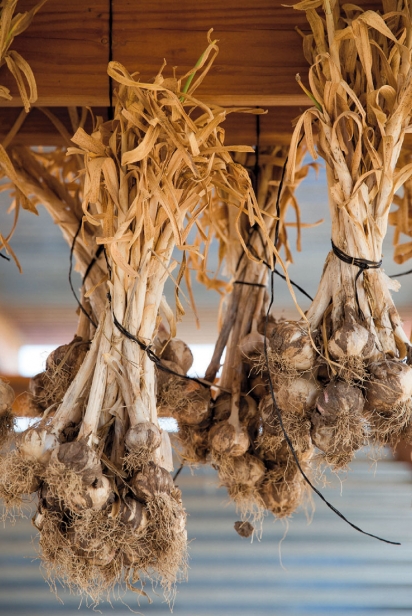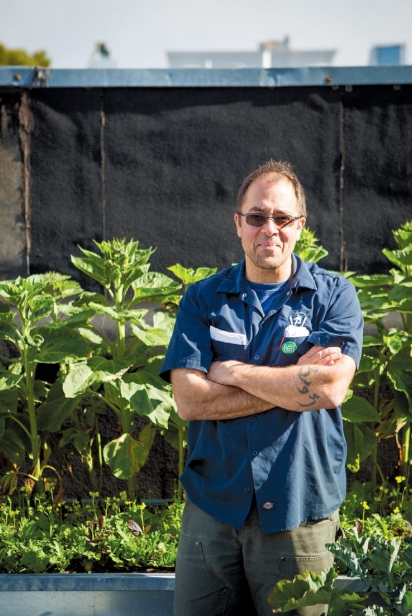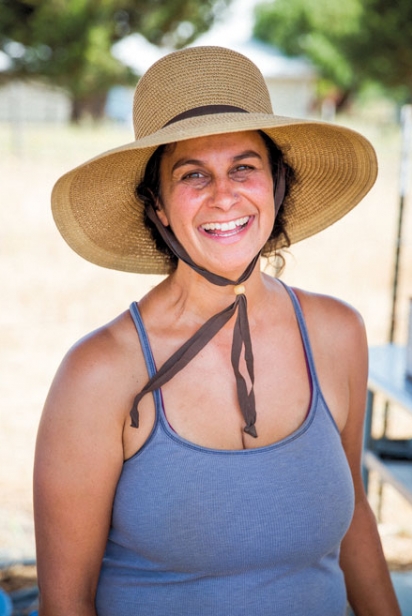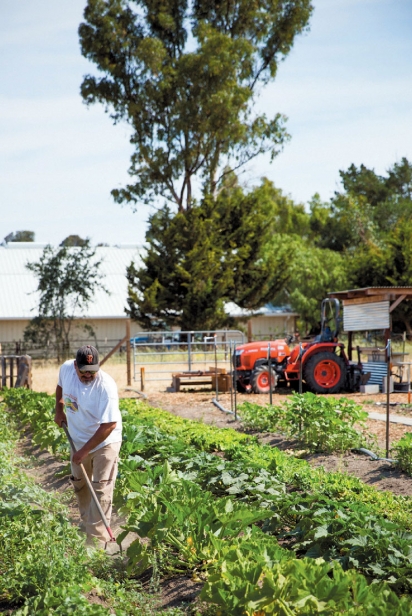Cultivating More Than Produce
Bi-Rite reaping lessons, connections from its farm ventures
“Summer squash, tomatoes—”
“We start green beans even before that.”
“We always start with baby lettuce.”
“Forono, which is an Italian slender beet that—”
“Radishes.”
“Hot peppers and frying peppers.”
“The melons worked out really good this year, the—”
“Squash, delicata and acorn.”
“The Crenshaw melon that is native to the area. The goal going forward is—”
“Eggplant, we grew some eggplant this year.”
Simon Richard and Sam Mogannam clearly can’t wait to tell me what they’re growing at Bi-Rite Market’s farm properties. We’re sitting in the office above Bi-Rite’s original location on 18th Street in San Francisco, and their words pile on top of each other like the pyramid of spring onions just one floor below.
From my research, Bi-Rite might well be the only urban grocery store in the country to successfully own and operate its own farm. Surprised? If you know Bi-Rite, probably not.
Since Mogannam took over the business from his father and uncle in 1998, Bi-Rite has grown from a single neighborhood market into an institution of the good food movement. Their enterprises currently include two retail markets, a catering business, a creamery, a community education center and the Bi-Rite farms (not to mention two cookbooks).
The farms—a triangle of city roof gardens and land in Sonoma County—are Bi-Rite’s most die-hard move yet in its evolving commitment to local food. Farming is not an easy “side business;” it’s grueling work, complicated to manage remotely, and not particularly lucrative.
But for Mogannam, starting a farm was worth the risk and a natural next step for the company. To be a truly well informed participant in our food system, as he sees it, Bi-Rite needed to grow food.
Plus, they get really excited about vegetables around here.
“I think like anyone who has experienced growing food from seed, Simon missed getting his hands in the soil,” said Mogannam. Richard Simon first came to Bi-Rite in 2002 after going to school and spending several years farming in Colorado. He’s now Bi-Rite’s produce buyer and manages the farm project.
They started to farm by looking upwards, beginning with a few raised beds for herbs and beehives on the 18th Street roof. In 2008, they dabbled on about a third of an acre on a Sonoma property, with Richard managing it from the city.
After a story about the farm appeared in Edible San Francisco, Mogannam was approached by a landowner in Sonoma County offering him the opportunity to farm an acre of land for $1,000. Simon came back from seeing the new land, his eyes wide after sticking his spade in the rich soil, crawling with worms. And so it began ...
The Sonoma property is smack in the middle of the Carneros wine region, just off Highway 121, around the corner from Fremont Diner and the Carneros Brewing Company. To the east and across the road, lines of vineyards swirl around the hills. On the other side, three cows graze on a flat dry field. A willowy eucalyptus tree provides the only shade. The soil is cracked from the sun, clay-like from the sodium- rich water, with a consistency that powders through your fingers. The growing conditions are tricky, but as a smartly dressed couple walks by while they wait for their table at the diner, it seems like exactly where Bi-Rite would find itself.
Yellow blossoms pop out from the rows of summer squash. Spring onions stretch a foot above the ground. There’s a small red barn with a faded hanging Bi-Rite sign. Tomatillos and Hopi beans are well on their way.
But why? Why would a successful urban market, with plenty of other projects on its plate, want to start its own farm? That was what I was there to find out.
Last year the farm recovered all its costs, which considering the economic reality for small-scale farmers should be considered a victory. According to the most recent USDA studies, about 90% of small farms have negative farm operating profits and depend on income from off-farm sources to make ends meet.
The closest comparison I could find to Bi-Rite’s farm-to-urban grocery store endeavor was in Minnesota, where for the past seven years the Wedge Community Co-op has owned and operated Gardens of Eagan, a farm about 40 miles from their headquarters. The co-op acquired the land at a vulnerable time for the local food system: A flood had just wiped out most of the area’s crops and a pipeline build- out threatened several farms. When a major supplier of local produce decided to retire, the co-op swooped in. Just last year they converted over 100 acres from conventional to organic farmland.
But in May, Wedge announced they would sell the farm. Hit by the expensive transition to organic and considering the increased availability of local, organic produce from other farms, the board decided the farm was too costly an investment, and it was time to pivot its focus back to retail.
If there are lessons to be learned from Wedge, Bi-Rite seems to be already on top of them.
“We’re trying our best to have it be as break-even as we possibly can. We’re not looking at it as being profitable, but we do feel a responsibility to make it sustainable financially,” said Mogannam.
To do that, Bi-Rite has done first what wise small farms do: They’ve diversified their crops, found products that fill a niche or have higher profit margins, extended their seasons and come up with value-added products.
They’ve also made slow, cautious investments. Only recently did they purchase a tractor.
They’re not organic certified—the cost and labor would be cumbersome, they say—and with a direct relationship to their consumers, there’s plenty of room for transparent dialogue around their “beyond organic” farming practices anyway.
The farm avoids competition with other local farms that sell to Bi-Rite by growing crops that are unique or that taste best when delivered extra fresh. The rest of it goes to the deli, creamery or into value-added products on the market shelves. Fresh green garlic becomes pesto. Peppers are pickled and added to sandwiches. There’s honey from the hives on the roof and jam made with fruit from their trees in Sonoma. It’s a constant process of evaluating what products work best for the market and deli, and what crops work best for the farm’s soil and climate.
Still, the sweetest rewards of operating a farm probably won’t ever fit in a shopping bag or ring up at the cash register. Digging deeper into farming meant developing the capacity to educate others on how to bring seed to plate. While independent sole proprietor farmers don’t have much time or capacity to provide education to the public, Bi-Rite does.
Layla Aguilar joined Bi-Rite as farm manager in 2013. The day I visit the farm, she wears a flower-printed hoodie over her head, protecting her from the breeze that whips through the farm at 8am. Around her forms a semi-circle of about 20 students. They’ve come, equipped with their water bottles and sun hats, for Bi-Rite’s Farm School, now in its fourth year.
Offered in conjunction with 18 Reasons, Bi-Rite’s community education center, the six-month curriculum includes six lectures in the city and six visits to the farm, with additional excursions to surrounding farms and gardens. The city classroom sessions explore the logistics and business of starting a rural or urban farm; the farm sessions put students to work digging, planting, weeding and harvesting.
This is this group of students’ second farm visit, and the onions they planted last time are nearly a foot tall. After watching the orange tractor till a few rows, the group splits up to transplant cucumbers, plant beans and prep trays bound for the greenhouse.
Students come for different reasons; several that I speak to work in tech. Everyone is financially comfortable enough to spend $600 on the course, although Simon mentions that they’re working on partnerships with local high schools to increase accessibility.
One student, Jessica Kleiderman, is starting a farm on her new property in Sebastopol. “I had this romantic notion of growing food on a larger scale, but I really needed to get my hands dirty and feel what it’s like to do something like plant a hundred feet of onion, and know the time that it takes and how it feels on your body,” she said. “It’s been super valuable to actually be doing these real farm projects.”
At the beginning of each farm session, Aguilar and another part-time farmer update the group on what’s been going on at the farm.
The garlic has been harvested, the gophers got a third of it. Once again, there was a failed bed of beets. The shiny streamers that look like tinsel hanging on sticks? Those are to keep the birds away. A student comments that a bird is sitting on a fence about a foot away from one.
This is the life of a small-scale organic farmer. Big agriculture farms rely on pesticides to fight predators, synthetic fertilizers instead of soil building and often only focus on growing one crop. But here it’s about trial and error. Battling pests. Experimenting with different crops, and sometimes losing them. It’s a pain, but each lesson brings Bi-Rite a little closer to the small farms they buy from.
“When you’re out there harvesting tomatoes and you realize that half are blemished, bug-eaten and rotten, and you’re only getting about half the yield on them, you get frustrated,” said Mogannam. “And then you share that with your farmers and they’re, like, ‘If I get half the yield I’m pretty excited!’”
There were also chickens that stopped laying, piglets that escaped their pen and a cow that broke the bank.
“Literally, by the time you try to take one cow to the slaughterhouse and then to the dude who’s going to split it and hang it, and then break it down into pieces that we can cut ourselves, it costs more than buying a cow from one of our farmers,” said Mogannam. “It’s incredible how expensive it is when it’s not done on this massive scale. That was another part of this eye-opening process for us.”
It’s lessons like these that Mogannam said have only furthered Bi-Rite’s mission to ensure the small-scale farmer’s viability, and encourage conversation about the real cost of producing the quality of food customers expect.
Learn more about the Bi-Rite family of businesses at BiRiteMarket.com








